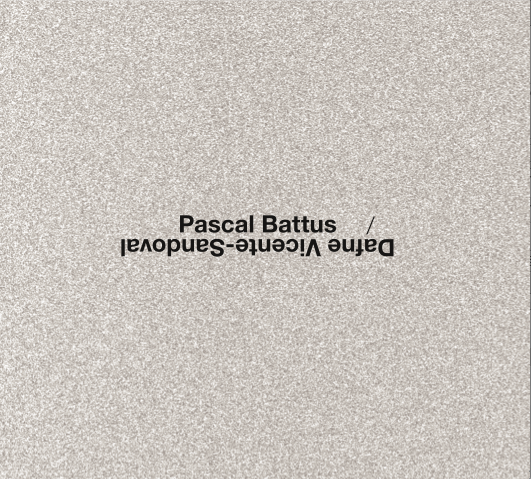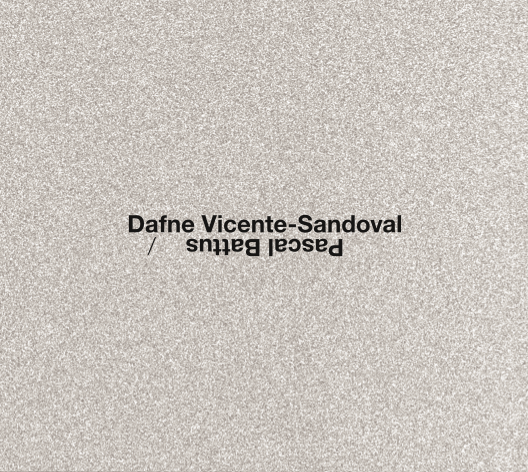| |
Je ne trouve pas les deux disques qui composent cette nouvelle sortie si différents, même si sur le premier l'amplification change quelque peu la donne. Au niveau dynamique, il y a de plus grands écarts, au niveau sonore, la palette est plus large, au niveau des textures c'est plus granuleux, plus saturé, et ainsi ce premier disque (intitulé Marne) paraît plus riche, plus complexe et ressemble plus à de la musique électroacoustique, que le deuxième (Seine), où Dafne Vicente-Sandoval délaisse ses micros et table de mixage pour n'utiliser plus que le basson, comme Pascal Battus qui laisse ses microphones pour n'utiliser plus que des papiers, plastiques, polyesthers et ses fameuses surfaces rotatives.
Mais dans le fond, je ne crois pas que le principal soit là. Tout n'est pas qu'une histoire d'outils, d'instruments et de textures. Ni de dynamiques. Le principal c'est peut-être la relation musicale qui s'est tissée dans ce studio d'enregistrement. La volonté d'explorer ensemble et de composer une nouvelle musique. Enfin nouvelle c'est vite dit, parlons plutôt de volonté de composer une musique avec du caractère. Car en fin de compte, sur ce disque, on se retrouve avec des larsens de table, des objets frottés et amplifiés par micro contacts, du bruit blanc, du souffle, des longues notes tenus : ce qu'on retrouve dans beaucoup de disques post-EAI ou réductionnistes en somme. Et pourtant il semble y avoir quelque chose en plus, ce que j'appelle le caractère. Pascal Battus et Dafne Vicente-Sandoval naviguent sur des terrains connus mais ils ont quelque chose de plus en commun. Quelque chose de discret et de subtil dans leur rapport au son, aux interactions. Pour moi ce duo se démarque car il ne cherche pas vraiment à se démarquer, pas ouvertement. Déjà, il y a les instruments, les sources sonores qui font que cette musique ne peut pas vraiment ressembler à aucune autre. Ce duo utilise un langage commun, mais tout de même personnel, avec son caractère propre et sa distinction.
Battus et Vicente-Sandoval fabriquent un univers sonore riche, un univers composé à deux de manière complémentaire et intime, où les musiciens tendent à se réunir sans pour autant se confondre : ils jouent sur les mêmes dynamiques et sur les mêmes intentions sans chercher à se ressembler, à se copier ou se dupliquer. Et puis il y a cette manière de composer la musique. Pascal Battus et Dafne Vicente-Sandoval fabriquent une musique intermédiaire qui se situe entre le calme et l'énergique, entre le bruitisme et la musicalité, ils naviguent sur un fil tendu entre une tension permanente et une détente constante sans faire dans la facillité des formes établies, et c'est ce qui fait le caractère de ce disque.
Julien Héraud l Improv Sphere l Mai 2016
|
| |
Two discs of beautiful minimal improvisation conjured on rotating surfaces, microphones, polystyrene, paper, plastic (Battus) bassoon, microphones and mixing desk (Vicente-Sandoval). I know a bit of Battus' approach, and find it fascinating to say the least. He activates various and sundry objects using the guts of old tape machines, their rotating spindles agitating whatever is in his hands.
A quick perusal of the web informs that on the first disc, titled Marne, the instruments were amplified with single close-up microphones. On Seine an acoustic approach was taken, offering slightly less detail. The nine tracks on the first disc have an alien "what's that sound?" quality, but the sounds themselves are so rich and the changes in them so interesting that they almost tug at the listener's ear. Bewitching. The soft whirrs, papery whispers and fluctuating drones create a collection of wholly individual sound worlds, each with its own sense of construction and logic.
None of the 15 short pieces stand out for me, they are all richly rewarding of strict attention. They're mostly on the quiet side, though the second disc does occasionally veer into more grating and louder territory, yet maintains the level of detail evinced throughout. Fog horns, electrical humming, low end throb, squealing high end whines and weird harmonic beating all step up and are recognized. Beautifully packaged in a fold out cover that's as minimal as the music.
Jeph Jerman l The Squid's Ear l March 2017
A late bump for this double CD of probing electroacoustic works by two fine French composer/improvisors, released by Potlach back in June. With one CD named Marne and the other Seine – presumably because the La Muse en Circuit studios where the duo was recorded stands at the junction of these two watercourses – it’s also no surprise the mysterious, inventive sounds herein evoke all sorts of watery allusions.
Marne, with its nine shortish pieces has a gravelly, kinetic feel, its sounds passing by like enigmatic debris tumbling through a brook, the scrunch and hiss of Pascal Battus’s equipment – polystyrene, paper, plastic and the rather wonderfully-titled ‘rotating surfaces’ – bringing a queasy tactility reminiscent of Gino Robair’s work (I’m reminded of his duo with John Butcher, Bottle Breaking Heart Leap, amongst many others). That quality is emphasised by the attentive mic’ing on this disc which brings the duo’s reduced sound world into full, vibrant life. Those rotating surfaces are quite something too, Battus salvaging tiny motors from devices like walkmans, and then using them to coax frictive groans and sighs from his materials. The result is a bristling intensity that coexists with Vicente-Sandoval’s righteous swathes of bassoon very effectively. In Trois,for example, Vicente-Sandoval lays down a disaffected, alien-sounding drone that merges with Battus’s micromechanical whines and growls, before the whole thing erupts into a blurt of distressed plastic-cup squeal. Cinq’s electro-data bursts and jetplane whooshes are similarly entrancing, their brevity only adding to the thrill.
Seine presents six longer pieces, unamplified, and with a widescreen aspect that contrasts with Marne’s up-close business. There are some similarities with the ruminative, extended tones of Kevin Drumm, Lucio Capece and Radu Malfatti’s The Volume Surrounds The Task, released by Potlach around the same time,and anyone who enjoyed that transposition of Wandelweiser-style compositional elegance into an improvisatory context will enjoy this too. Here, Vicente-Sandoval and Battus create challenging, monolithic, enigmatic works, pieces for which fewer words work best and which create a particular type of meditative blankness. Sandoval’s bassoon is restrained and focused, producing hymnal drones that roll out like an eternal plain. Battus is similarly nuanced, replacing the nerviness of the Marne pieces with subtle tonal interventions, sometimes ruffling the surface and edges of Sandoval’s playing, as on Dix, where the duo summon images of helicopters buzzing a distressed mammoth, other times flitting around like mayflies in the sunlight. If the nervy scuffs and hums of Marne are a bustling torrent, Seine is a silty estuary: slow moving, deep, unknowable.
Paul Margree l We need no swords l December 2016
Bassoonist Dafne Vicente-Sandoval and surface agitator Pascal Battus practice electro-acoustic improvisation, and it’s hard to get more literal about it than they do on this double CD. The first disc, subtitled Marne, cites microphones and mixing desk amongst the two players’ instrumentation. The second, subtitled Seine (the session was recorded in a studio located near where the two rivers converge), duplicates the instrumentation (rotating surfaces, polystyrene, paper, plastic, and bassoon) except for the mics. On each, the musicians improvise performances that emphasize texture, tone, and presence, but concede nothing to beats, tunes, or conventional sonic building blocks. Instead they scrape and blow, generating sonic convergences that only occasionally remind you that people or intentionally played objects were involved in their creation. The amplified disc jabs at you while the acoustic one seems to recede as you approach it, but each forces the listener to reckon actively with the sounds and become aware of listening as an act.
Bill Meyer l Dusted l July 2016
This double CD features the duo of Pascal Battus on rotating surfaces, styrofoam, paper, plastic objects and microphones plus Dafne Vicente-Sandoval on bassoon, microphones and mixing board. Although the two have not recorded together previously, they have each recorded before for Potlatch, in duos that were similar enough to be seen as preparation for this meeting, Battus with saxophonist Christine Sehnaoui Abdelnour on Ichnites (2010) and Vicente-Sandoval with Klaus Filip playing sine waves on Remoto (2013). Each of those albums combined and contrasted sounds from the wind instrument with the non-instrumental sounds. In fact, this eponymous album completes a neat trilogy with those two older releases.
Its two discs were recorded in March 2015 at La Muse en Circuit studios, Alfortville, situated at the junction between the rivers Marne and Seine. On the first disc, subtitled "Marne", the instruments were amplified with single small microphones put close to them and, on the second, "Seine", they were played acoustically. "Marne" consists of nine tracks, totalling forty-three minutes and ranging in length from under two minutes to nearly nine minutes. "Seine" features six longer tracks, totalling over fifty-two minutes, the longest lasting nearly thirteen minutes.
The use of microphones on "Marne" introduces a qualitative difference between the two discs. On "Marne", the sound has an immediacy and intimacy that can make the listener feel as if they are right inside the bassoon or adjacent to the speakers, while on "Seine" the listener is further away, more in the role of an audience member. The two discs are in stark contrast, but rather than one being "better" than the other, the two complement one another and together give a fuller picture than either would do alone. Exactly the same is true of the two performers; although it is not always played conventionally, the bassoon contrasts with the impressive range of sounds and noises generated by Battus. However, the contrast between them does not make them incompatible as both players are clearly mindful of finding common ground and making the combination work. The end result is a rich, diverse eai album that never becomes trite or formulaic, but sounds fresh each time it is played.
John Eyles l All About Jazz l June 2016
|

